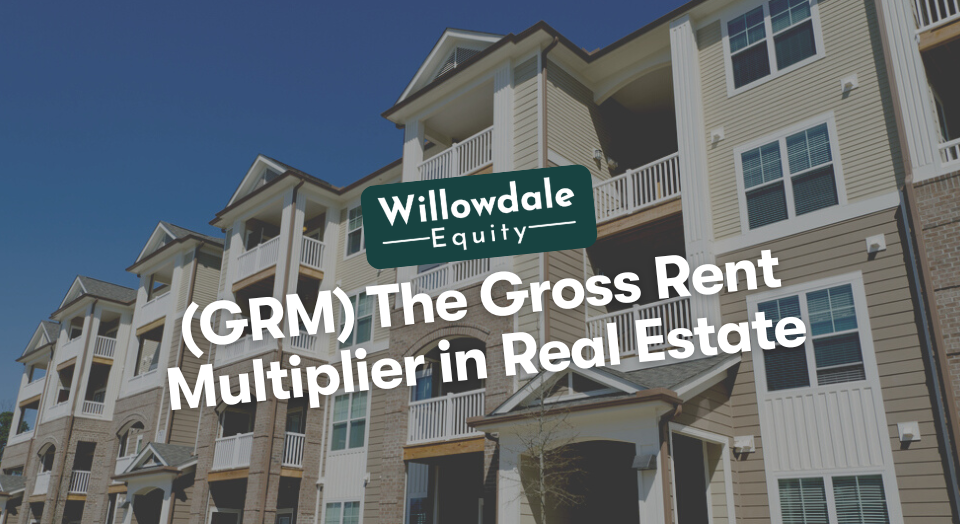
What is a Gross Rent Multiplier in Real Estate? – Calculating the (GRM)
This article is part of our guide on what a good cap rate is for multifamily, available here.
When investing in real estate, carefully reviewing the property’s finances is very important. While a property may appear worthwhile after analyzing one metric, other metrics could indicate future problems after investing in the property. One such metric is a property’s gross rent multiplier.
This metric, along with its CAP rate and several others, helps investors make better decisions and increase their return on invested capital. Understanding this multiplier is critical when dealing with multifamily properties, especially in competitive markets.
Key Takeaways
-
A property’s gross rent multiplier (GRM) is its fair market value (or sale price) divided by its gross rental income.
-
There is no single “good” gross rent multiplier due to market differences. However, a multiplier of 4-7 is usually considered good.
-
It may seem like the lower the GRM, the better. However, a multiplier that is too low is likely an indicator that there is something wrong with the property.
What is a Gross Rent Multiplier? - GRM Definition
A property’s gross rent multiplier (GRM) is its fair market value (or sale price) divided by its gross rental income. The GRM helps investors determine how competitive a property’s rents are compared to its actual value. This is a valuable metric when determining a property’s income generation potential relative to its market value in the event of a sale.
Because this value uses gross potential income instead of net income, you can compare it to a metric that uses a net rent figure to determine the property’s future gross income potential after solving some problems and increasing its value.
How do you Calculate Gross Rent Multiplier? - GRM Real Estate Formula

The formula for GRM is the property’s actual value divided by its gross rental income. The gross rental income assumes that the property has 0% vacancy and the currently vacant units will be rented at the market rate.
Let’s assume a 6-unit multifamily building is valued at $1,200,000 in a particular area. This is the property’s real value. Now let’s assume that market rent is $1,100/month, and the one vacant unit typically also rents for $1,100/month. The property’s total monthly gross rental income (GRI) is $6,600 per month or $79,200 annually. The GRM is calculated using the property’s annual gross rental income, considering the actual income and the potential income for vacancies based on the market rate of similar units.
In this case, $1,200,000 divided by $79,200 is 15.1. Generally, the lower the multiplier, the better the investment performs. However, this metric has several nuances to consider when making investment decisions. A figure that’s too low may also be a red flag.
It’s also important to note that things like the loss to lease raise the GRM as the property is not achieving full market rents for all or a portion of their unit mix.
What is a Typical Gross Rent Multiplier?
The short answer is that there is no typical number when using the gross rent multiplier formula. This is because this metric is extremely market-specific, both geographically and cyclically.
Some markets are much more competitive than others, driving down the yield. For example, property values are extremely high in markets like New York or San Francisco. Even though rents usually keep up in markets like this, the gross rent multiplier will remain higher than in a less competitive market.
An example of a less competitive market would be Nashville, Tennessee. In Nashville, rental properties will be much cheaper than in New York, and their rents, although lower, will be higher relative to the property’s market value. Therefore, the GRM will be lower.
This multiplier is also affected by market cycles. During a period of strong economic growth, rental property value will typically increase. While rents also increase, they are a lagging indicator and can usually only be raised once a year. This circumstance would increase the property’s GRM. However, during a recession, property value might fall while rents remain the same (it’s very unusual for rents to fall). This scenario creates a great buying opportunity for a real estate investor. You would likely see a decrease in gross rent multipliers in the market.
As of mid-2022, the economy has entered a recession, and housing prices are starting to weaken. This is a good buying opportunity for investors as rents will likely continue to grow and remain high while there are fewer buyers to compete against. With a simultaneous rise in interest rates, investors will be able to take advantage of the high potential income of properties while simultaneously writing more off from taxes due to interest.
What is a Good Gross Rent Multiplier?
There is no single “good” gross rent multiplier due to market differences. However, a multiplier of 4-7 is usually considered good. It may seem like the lower the GRM, the better. However, a multiplier that is too low is likely an indicator that there is something wrong with the property. When a multiplier is low, it’s important to determine how much it will cost to rehab the property and whether or not there is an unusual market circumstance that might temporarily impact the GRM.
Multipliers will also be higher in competitive markets and lower in less competitive markets. While a building in New York City will have lower returns, the probability that an appropriately priced apartment will sit vacant for more than a few days is quite low.
On the other hand, a smaller market like Nashville will have better returns for investors but is not as liquid as a primary market like New York. Like any other investment, higher uncertainty yields higher returns.
What is a good Gross Rent Multiplier for Commercial Property?

Markets, however, are evolving, and it’s becoming more difficult to say what a universally “good” multiplier truly is.
As previously mentioned, comparing the metric with properties in that same market is best. In an inflationary environment, rents may take some time to catch up to the inflation in the price of the real estate itself.
CAP Rate vs GRM, What's the Difference?
You may now be wondering why we don’t just look at the cap rate as it also represents the return of a property relative to its value. A cap (capitalization) rate takes a property’s net operating income (NOI) and divides it by its asset value.
GRM gives real estate investors a quick way to evaluate a property’s investment potential, whereas a cap rate shows a property’s return relative to current rental income. Cap rates tell you nothing about the property’s potential.
Where GRM fits in your Quick Analysis of a Property
Let’s say you’re looking at three potential investment properties in the same market. When analyzing the properties’ financial information, one property has a GRM of 4 while the other two have a GRM of 10. You may think that this makes the property a good deal; the income-generating potential of the property is quite well relative to its price.
You could get into trouble if you purchase this rental property based on this information alone. When you dig a little deeper, you learn that the property’s cap rate is 3%. You dig further and discover that the property has very high operating expenses, and you likely won’t be able to reduce these. There are also no vacancies, and the property can’t generate additional revenue through parking, storage, laundry, or other income-generating additions.
You then look at the two other properties and see that despite a higher GRM, the cap rates are 5% and 6%, respectively. Expenses are much more manageable, and there are a few vacancies. As a result, there’s more potential to add value to the latter two properties.
Without looking at other metrics, it would have been difficult to assess these opportunities fully.
Frequently Asked Questions About the GRM Formula & GRM in Real Estate
A high gross rent multiplier means that a property is generating relatively little gross rental income relative to its fair value.
The GIM is essentially the annualized version of the GRM, using a property’s annual gross rental income instead of its monthly gross rental income.
What is the Gross Rent Multiplier - Conclusion
Now that you know more about a property’s gross rental multiplier, you’ll be able to add this metric when analyzing an investment property. While this metric alone may be misleading, combining it with a property’s car rate and other financial metrics will increase the odds of picking a winner.
If you’d like to learn more about investing in multifamily real estate and have access to a network of investors and exclusive investment opportunities, consider joining the investor club.
Sources:
- NewSilver, “What is a Good Gross Rent Multiplier“
- Rocket Mortgage, “Understanding Gross Rent Multiplier as an Investment Tool“
Interested In Learning More About PASSIVE Real Estate Investing In Multifamily Properties?
Get Access to the FREE 5 Day PASSIVE Real Estate Investing Crash Course.
In this video crash course, you’ll learn everything you need to know from A to Z
about passive investing in multifamily real estate.
We’ll cover topics like earned income vs passive income, the tax advantages, why multifamily, inflation, how syndications work, and much much more!




